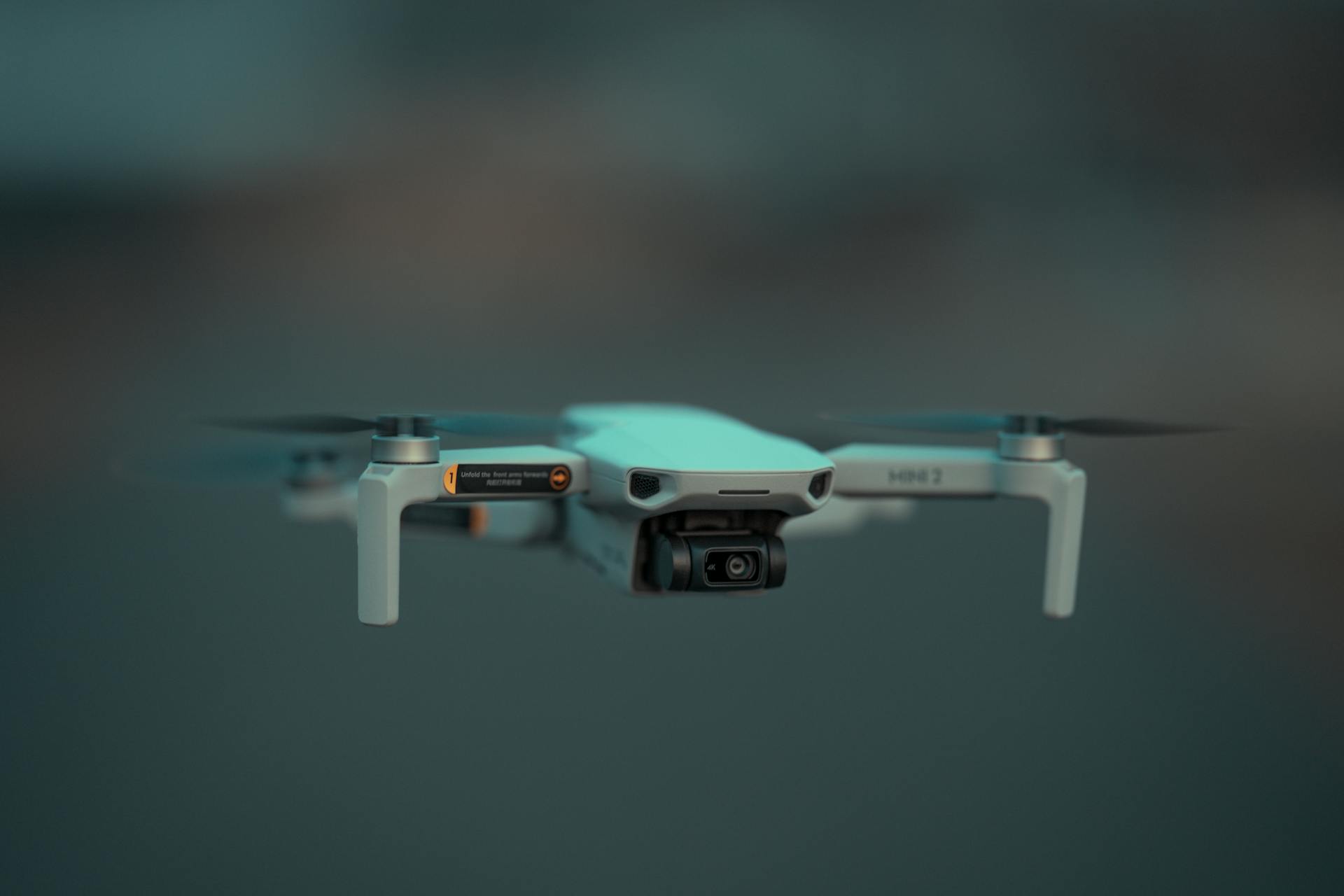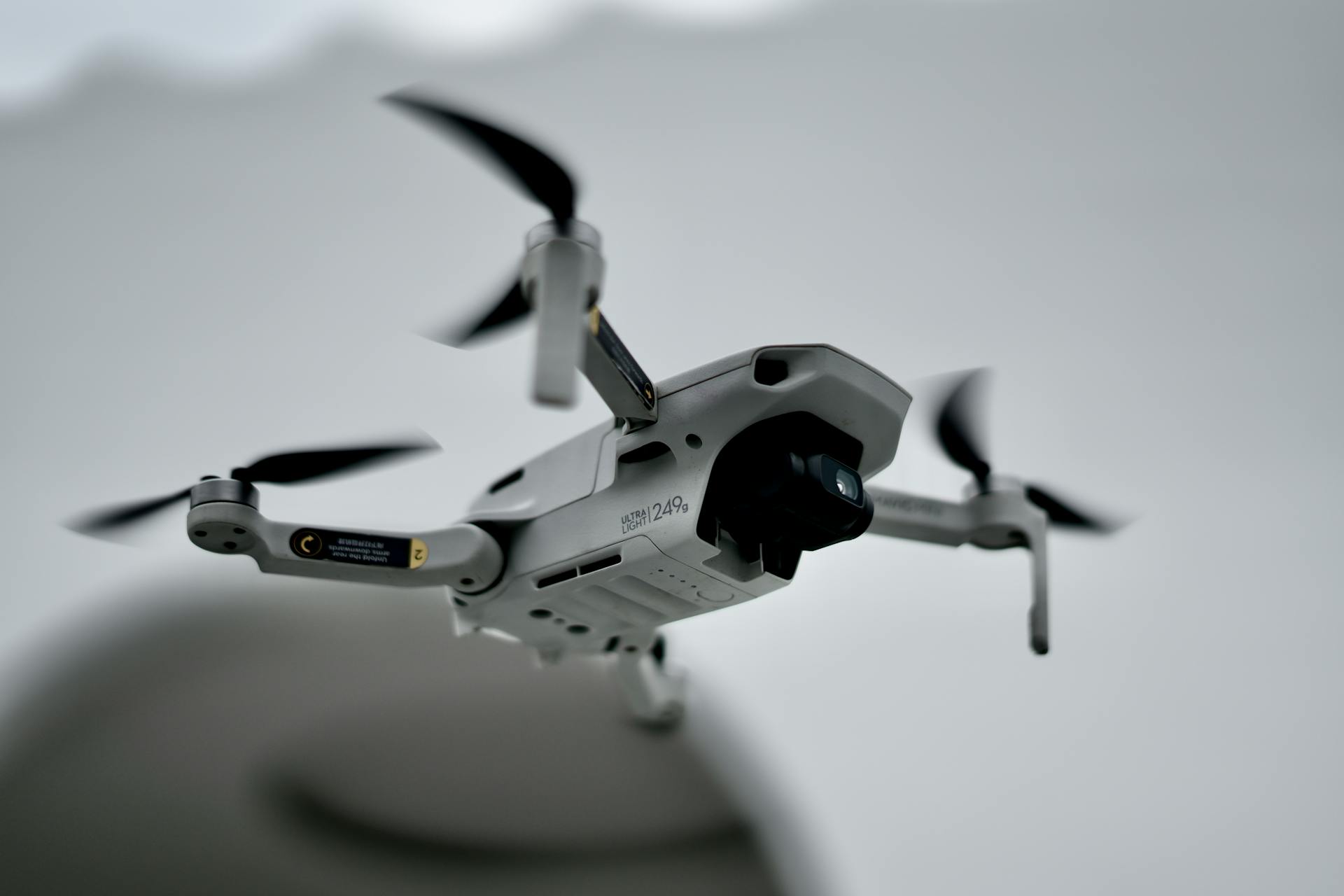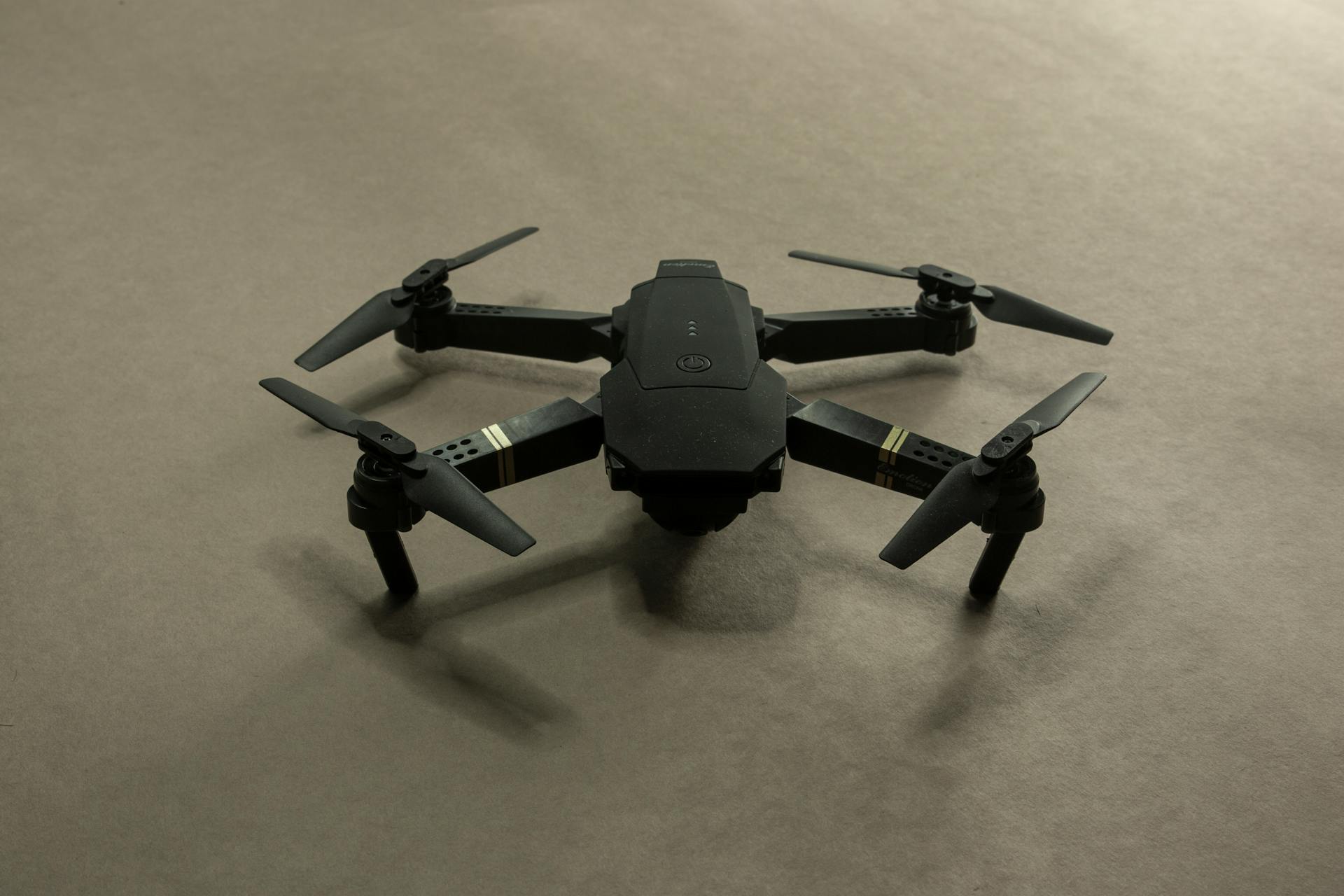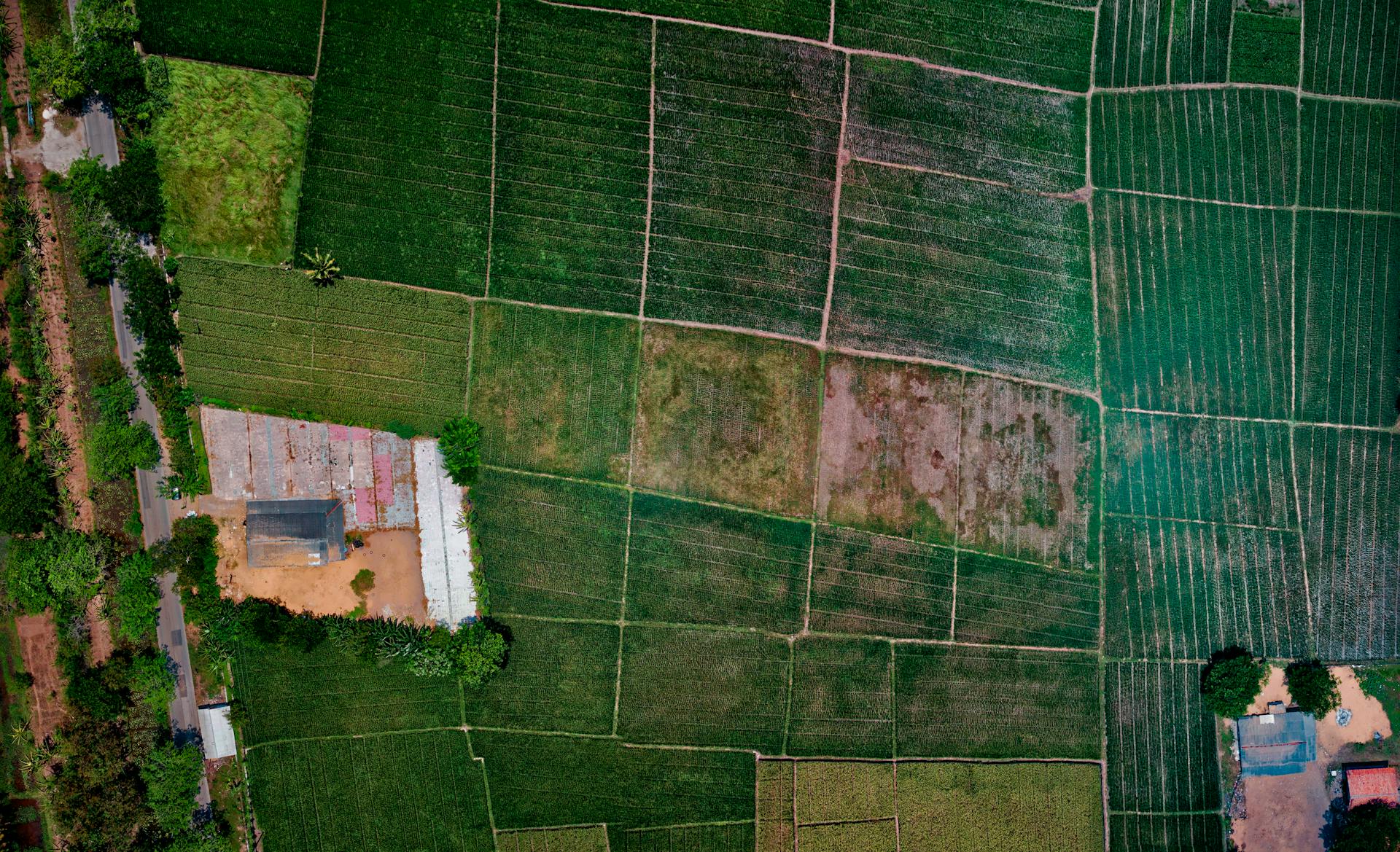
A drone quadrotor is essentially a type of unmanned aerial vehicle (UAV) that uses four rotors to generate lift and propulsion.
These rotors are typically arranged in a square or X configuration, which allows for stable and precise flight.
Each rotor is powered by an electric motor, which is controlled by a flight controller that regulates the speed and direction of the rotors.
The flight controller is the brain of the drone, processing data from various sensors to maintain stability and altitude.
The quadrotor's design enables it to hover in place, move forward, backward, left, and right, as well as perform complex maneuvers like flips and rolls.
Its ability to maintain stability and control makes it a popular choice for recreational and commercial use alike.
Related reading: Military Drone Controller
Design and Construction
Design and construction of a drone quadrotor is a crucial step in building a reliable and efficient flying machine. The main mechanical components are a fuselage or frame, the four rotors (either fixed-pitch or variable-pitch), and motors.
The choice of frame is essential, as it influences the drone's size, weight, and payload capacity. Materials vary from carbon fiber for strength and lightweight to aluminum and plastics for beginners and budget builds.
For best performance and simplest control algorithms, the motors and propellers should be equidistant. Motors provide the necessary thrust, while propellers translate this into lift, so they should be selected based on their compatibility with the motors and the desired lift efficiency.
Here's a brief overview of the components you'll need to build a quadcopter:
A well-designed and constructed drone quadrotor is the foundation for a successful flying experience.
Building a Quadcopter
Building a quadcopter requires careful consideration of its mechanical structure. The main components include a fuselage or frame, four rotors, and motors, with motors and propellers being equidistant for best performance and simplest control algorithms.
The frame is the backbone of your quadcopter, influencing its size, weight, and payload capacity. Materials vary from carbon fiber for strength and lightweight to aluminum and plastics for beginners and budget builds.
Choosing the right frame is crucial, as it affects the drone's performance. Consider the size, weight capacity, and material based on your flying intentions.
Motors provide the necessary thrust, while propellers translate this into lift. The size and power of the motors should correspond to the frame size and overall weight of the quadcopter.
The following components are essential for building a quadcopter:
- Frame
- Motors
- Propellers
- Electronic Speed Controllers (ESC)
- Flight Controller
- Power Distribution Board (PDB)
- Battery
- Radio Transmitter and Receiver
Current Developments
The design and construction of quadcopters are advancing rapidly.
The Bell Boeing Quad TiltRotor concept is a significant development, combining the fixed quadcopter concept with the tilt rotor concept to create a C-130 sized military transport.
Airbus is also pushing the boundaries with its battery-powered quadcopter, designed as an urban air taxi.
This urban air taxi will initially have a pilot but could potentially become autonomous in the future.
If this caught your attention, see: Micro Air Vehicles
Flight Principles
Quadcopters rely on Newton's Third Law of Motion to generate lift and ascend into the air. The law states that for every action, there is an equal and opposite reaction, and in the case of a quadcopter, the action is the propellers spinning and pushing air downwards.
If this caught your attention, see: Use of UAVs in Law Enforcement
The reaction to this action is an upward force exerted on the quadcopter, known as lift. This lift force must surpass the force of gravity acting on the quadcopter for it to rise. Achieving a hover state involves balancing the lift force with gravitational pull, maintaining a steady altitude without vertical movement.
Each spinning propeller generates a torque that tends to rotate the quadcopter's body in the opposite direction. To counteract this effect, two propellers are designed to spin clockwise and the other two counter-clockwise, canceling out the opposing torques and stabilizing the quadcopter.
Lateral movement is initiated by changing the speed of the propellers, resulting in an uneven distribution of lift. Increasing the speed of two propellers on one side of the quadcopter and decreasing the speed of the two propellers on the opposite side leads to lateral movement towards the side generating less lift.
Consider reading: Military Drone Speed
Lift and Stability Principles
Lift is the upward force that enables a quadcopter to ascend and navigate through the air, thanks to Newton's Third Law of Motion, which states that for every action, there is an equal and opposite reaction. This principle is what allows a quadcopter to rise into the air.
The action occurs when the propellers spin, pushing air downwards, and the reaction is an upward force exerted on the quadcopter, known as lift. The magnitude of this lift must surpass the force of gravity acting on the quadcopter for it to begin rising.
To achieve a hover state, a quadcopter must balance the lift force with gravitational pull, maintaining a steady altitude without vertical movement. This balance is crucial for stable flight.
Each spinning propeller generates a torque that tends to rotate the quadcopter's body in the opposite direction, which could destabilize the quadcopter if not properly managed. This effect is counteracted by designing two propellers to spin clockwise and the other two counter-clockwise.
This arrangement cancels out the opposing torques, stabilizing the quadcopter and allowing it to maintain a steady altitude. By controlling the speed and direction of the propellers, a quadcopter can achieve precise lift and stability.
Explore further: High Altitude Long Endurance Uav
Air
The air is where it all happens in flight, and it's essential to understand the basics of aerial performance.
Autonomy is a critical factor, with some systems offering up to 10 minutes of uninterrupted flight time.
Aerial coverage is also crucial, with some systems designed to maximize airtime and area covered.
Maximum altitude is another key consideration, with some systems able to fly as high as 100 meters.
Fully autonomous systems, like the TOR Robotics Q-4 Drone, can fly on their own, expanding capabilities in various applications.
You might like: Puma Unmanned Aerial Systems
Flight Controls
Flight Controls are the brain of your drone quadrotor, and they're what make it possible to control the aircraft remotely. The Flight Controller is the device that controls the speed of your motors by sending signals to your ESCs.
Advanced flight controllers have more features and are coupled with sensors such as gyros, accelerometers, sonar, GPS, and magnetometers. Simple flight controllers contain only gyros and are quite sufficient for most beginners.
The Flight Controller accepts the signals from the onboard radio receiver, allowing you to control your quadcopter remotely. It then does its magic and sends signals to the ESC's to control the motor speeds.
Intriguing read: Drone Remote Controller
Flight Controllers
The flight controller is the brain of your quadcopter, controlling the speed of your motors by sending signals to your ESCs.
It's a small computer that can be programmed and updated by connecting it to your computer. This makes it a relatively affordable and accessible part of the quadcopter's system.
Flight controllers come in different levels of complexity, with advanced ones featuring more sensors like gyros, accelerometers, sonar, GPS, and magnetometers. Simple flight controllers contain only gyros and are sufficient for most beginners.
The flight controller accepts signals from the onboard radio receiver, allowing you to control your quadcopter remotely. It then does its magic, sending signals to the ESCs to control the motor speeds.
Flight controllers can be coupled with sensors to provide more precise control and navigation. This is especially useful for complex swarming behavior and autonomous flight.
Recommended read: UPS Flight Forward
Roll
To roll your drone, you need to push the right stick to the left or right, which controls the drone's lateral orientation.
This adjusts the drone's side-to-side movement, allowing you to bank and turn.
For a roll to the left, the flight control system decreases the speed of propellers #3 and #4 while increasing the speed of propellers #1 and #2.
This imbalance causes the drone to tilt and roll to the left, creating lateral force for sideways movement.
To maintain altitude during this maneuver, you must increase the speed of all four propellers to counteract gravity.
The faster you increase the propeller speed, the more stable your drone will be during the roll.
Components
A quadcopter's components are what make it fly. The frame is the backbone, made from materials like carbon fiber, aluminum, or plastics, and it influences the drone's size, weight, and payload capacity.
The motors are crucial, providing the necessary thrust. Most quadcopters use brushless DC motors, which have three wires controlling the motor's phases. You can control the motor's direction by changing the connections on these wires.
Recommended read: Quadrotor Motor
To choose the right motor, consider the quadcopter's weight, with heavier drones requiring motors in the 700-900 KV range. For smaller drones, motors with KV ratings between 1300 and 2200 are suitable. The maximum current rating of the motor is also important, as it affects the choice of electronic speed controller (ESC) and battery.
Here are some key motor specifications to look out for:
- KV rating: measures revolutions per minute (RPM) per volt, with typical ratings between 500 and 2500
- Thrust rating: specifies the motor's ability to generate thrust in conjunction with a propeller size
- Shaft diameter: determines the compatible propeller size
- Mounting screw pattern and motor mounts: ensure the motor can be securely attached to the frame
Quadcopter Definition
A quadcopter is an unmanned aerial vehicle (UAV) characterized by its four rotors, each equipped with a motor and propeller. This unique design allows quadcopters to be agile and stable in the air.
Quadcopters have four rotors, which provide lift and propulsion. This configuration enables them to hover and maneuver with precision.
Each rotor on a quadcopter is equipped with a motor and propeller, which work together to generate thrust and lift. This setup allows quadcopters to achieve a high level of control and stability.
A different take: Quadcopters Drones
Motors
Motors are a crucial component of a quadcopter, and selecting the right ones can make all the difference in its performance. Motors are responsible for generating the thrust that lifts the quadcopter off the ground and keeps it flying.
Most quadcopters use brushless DC motors, which consist of a rotor with a permanent magnet and a number of electromagnets surrounding it. These motors can have anywhere from 2 to 14 poles, with more poles allowing for more precise control.
A key specification of a quadcopter motor is its KV rating, which measures the number of revolutions per minute (RPM) the motor will turn when a 1-volt potential difference is applied. Typical KV ratings for quadcopters range from 500 to 2500, with lower KV motors suitable for larger propellers and higher KV motors for smaller propellers.
The maximum current rating of the motor is also important, as it determines the power required to control it. You'll need to choose an ESC that can handle the motor's maximum current to avoid damage.
Here's a rough guide to motor selection based on quadcopter weight:
The thrust rating of a motor is specified in conjunction with a propeller size, and it's essential to match the motor to the propeller for stability, especially when carrying a camera.
Radio Equipment
Radio equipment is a crucial component of your quadcopter, and it's essential to understand how it works.
A quadcopter will have an on-board radio receiver and you will control the device with a handheld radio transmitter.
The number of channels in the radio system determines how many functions or devices you can control in your quadcopter. Most people start with at least six channels.
Each channel controls a single function or device, and you'll need at least four basic channels to control the quadcopter's movement. These channels are used for throttle, yaw, pitch, and roll.
You can use extra channels to control lighting or a gimbal motor to position a camera. Some people also use channels to switch between different flying modes.
If you plan to use several quadcopters, you can buy one transmitter and several compatible receivers. This will save you money, as receivers are generally fairly inexpensive.
Transmitter-receiver combinations work in two different modes, which determine the control configuration on the transmitter. The most popular configuration is mode 2, where the elevator control is on the left joystick and the throttle control is on the right joystick.
Related reading: Remote Control Military Drone
Batteries
Larger batteries have larger capacities, which allow for longer flight times. However, they also weigh more, which reduces flight time and makes the quadcopter less agile.
A battery's current capacity is its most important specification, rated in milliamps per hour (mAh). For example, a 2200 mAh battery can supply 2.2 amperes of current for 1 hour.
Batteries consist of multiple cells, each delivering 3.7 volts. Common battery voltages are multiples of 3.7 volts, such as 3.7, 7.4, 11.1, and 14.8 volts.
If you choose a higher voltage battery, make sure your ESC and motors can support that voltage.
See what others are reading: Ace Combat Drones
Quadcopter Types
Quadcopter Types offer a range of design options to suit various flying styles and needs. Each type has its unique characteristics and advantages.
The X Quadcopter is a versatile design used for aerial photography, videography, racing, and acrobatic stunts. It comes in various frame shapes, including true X, square, hybrid X, and stretched X.
The H Quadcopter features an H-shaped frame and is known for its stability. This makes it a great option for beginners or those who want a reliable flying experience.
For those who enjoy acrobatic flying, the + Quadcopter excels in straight flight paths with aerodynamically efficient propeller positions.
Here's a brief overview of some common quadcopter types:
Types of Quadcopters
Quadcopters come in various shapes and sizes, each designed for specific uses. The most common types include the X Quadcopter, known for its versatility and use in aerial photography, videography, racing, and acrobatic stunts.
The X Quadcopter is a true marvel, with frame variations including true X, square, hybrid X, and stretched X designs. These variations offer a range of options for pilots to choose from, depending on their specific needs.
For those looking for stability, the H Quadcopter is the way to go, featuring an H-shaped frame that provides excellent stability.
The + Quadcopter excels in straight flight paths, thanks to its aerodynamically efficient propeller positions. This makes it a popular choice for acrobatic flying.
The Y4 Quadcopter offers a unique design, with two motors mounted coaxially on the rear arm, providing better yaw control and lifting power.
The V-tail and A-Tail Quadcopters offer enhanced yaw control through rear motors mounted at an angle, utilizing thrust for turning. These designs provide a more precise and agile flight experience.
Here are the main types of quadcopters and their characteristics:
Quadri Hybrid
The Quadri Hybrid is a unique and reliable option for those who need a quadcopter that can handle heavy loads and long flights.
It can carry a maximum load of 10 kg, which is impressive for a quadcopter of its size.
With a maximum autonomy of 40 minutes to 240 minutes, you can fly for a long time without needing to recharge.
This quadcopter is designed to fly high, with a maximum altitude of 3,500 m to 5,000 m, giving you a bird's eye view of your surroundings.
The Quadri Hybrid also features back-up batteries that kick in during a breakdown, giving you 3 minutes of extra autonomy to land safely.
A unique perspective: Dji Go App Phantom 3 Standard
Ua Valbris
The UA Valbris is a highly innovative drone that makes operation easy and effective, even for inexperienced users. Its interaction with the drone is highly intuitive.
You can choose how to fly the UA Valbris, with options for GPS-guided flight, live-streaming, or starting in autonomous mode and going live on demand. This level of flexibility is a big advantage.
The UA Valbris is designed to be easy to use, making it perfect for those who are new to drone operation. Its innovative design ensures that even beginners can get the most out of their drone.
Frequently Asked Questions
What is the difference between a quadcopter and a quadrotor?
There is no difference between a quadcopter and a quadrotor, as both terms refer to the same type of uncrewed rotary wing aircraft. The terms are often used interchangeably, with "quadcopter" being more commonly used in consumer products and "quadrotor" in technical and research contexts.
Featured Images: pexels.com


